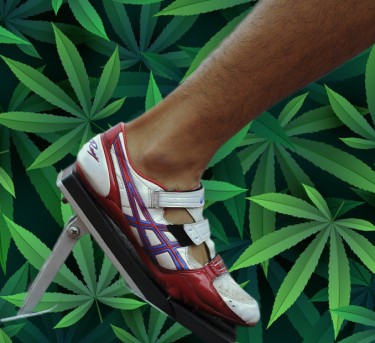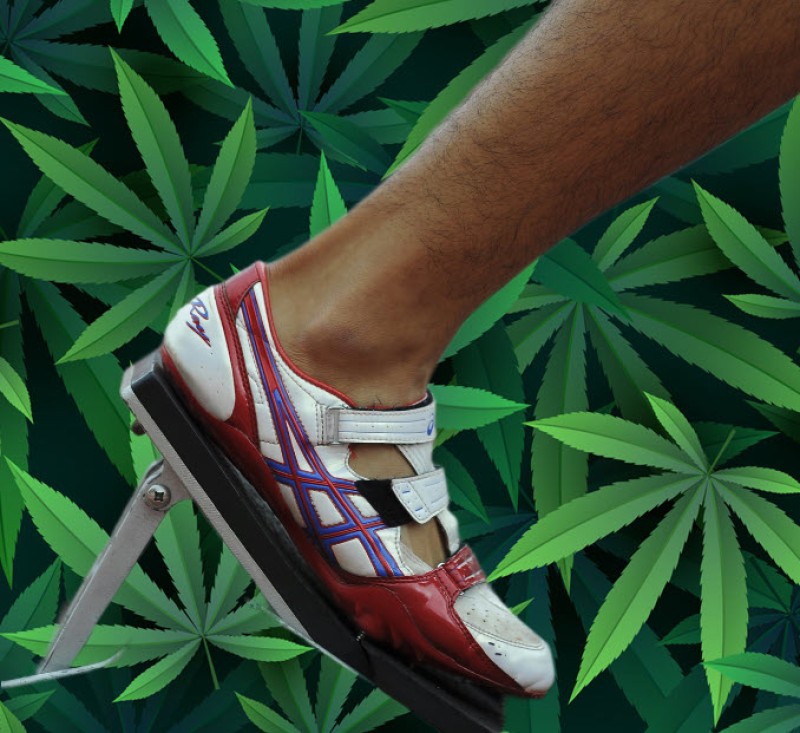
Cannabis Athletes: How Marijuana Users Are Crushing Fitness Stereotypes
Picture this: a cannabis user gets up early, hits the gym for an hour-long workout, then grabs a protein smoothie on the way to work. If this doesn't match your mental image of a "typical stoner," you're not alone—but you might want to update your assumptions. A groundbreaking new survey from NuggMD has shattered one of prohibition's most persistent myths by revealing that cannabis consumers are actually fitness enthusiasts who exercise regularly, eat healthier, and maintain more active lifestyles than the general population.
The numbers are staggering and completely contradict decades of "lazy stoner" stereotypes. Cannabis users are more than three times more likely to exercise regularly than to drink alcohol, and they're nearly five times more likely to work out than to eat fast food. In fact, over 62% of cannabis consumers exercise daily or multiple times per week, while only 13% consume fast food with similar frequency.
These findings represent more than just interesting statistics—they're evidence of a fundamental shift in cannabis culture and user demographics. The days of the couch-locked Cheech and Chong stereotype are over. Today's cannabis consumers are wellness-focused individuals who use the plant to enhance their fitness routines, improve recovery, and optimize their overall health.
As Andrew Graham, head of communications at NuggMD, noted: "This finding is yet more evidence that today's cannabis consumers defy the prohibitionist stereotype of layabouts munching Doritos and then crossfading with booze to get their fix." The data reveals a cannabis community that's more health-conscious than the average American, challenging every assumption prohibition advocates have made about marijuana users.
This athletic revolution isn't just changing perceptions—it's redefining what cannabis culture looks like in the post-prohibition era. From yoga studios to CrossFit boxes, from hiking trails to cycling groups, cannabis users are leading active, healthy lifestyles that would make fitness influencers jealous.
The Data: Cannabis Users Choose Gyms Over Fast Food
The NuggMD survey of 603 cannabis consumers reveals lifestyle patterns that completely obliterate stoner stereotypes. When asked about their daily and weekly habits, cannabis users reported exercise rates that shame the general population while showing remarkable restraint around activities typically associated with unhealthy lifestyles.
The exercise numbers are particularly impressive: 27.4% of cannabis consumers exercise daily, while another 34.9% work out multiple times per week. This means nearly two-thirds of cannabis users are getting regular physical activity—rates that exceed national averages for the general population, where less than 25% of adults meet federal exercise guidelines.
Compare this to alcohol consumption among the same cannabis users: only 6.1% drink daily, and just 11.3% drink multiple times per week. The stark contrast reveals a community that prioritizes physical wellness over chemical intoxication, choosing endorphins over ethanol.
The fast food comparison is even more dramatic. Only 1.5% of cannabis users eat fast food daily, and just 11.5% consume it multiple times per week. This makes cannabis users 4.8 times more likely to exercise regularly than to eat fast food—a ratio that suggests these aren't people making impulsive, unhealthy decisions but rather individuals focused on long-term wellness.
Other survey findings support this health-conscious profile. Nearly 70% of cannabis users drink coffee regularly—suggesting active lifestyles that benefit from caffeine's performance-enhancing effects. Almost 65% take nutritional supplements, indicating attention to optimizing their health beyond just basic nutrition. Meanwhile, only 3.3% use food delivery services daily, showing preference for home-prepared meals over convenience foods.
The survey also revealed that cannabis users aren't particularly interested in sedentary entertainment. Only 4.5% frequently visit movie theaters, suggesting they prefer active pursuits over passive consumption. These patterns paint a picture of individuals who use cannabis as part of balanced, health-focused lifestyles rather than as escape from reality.
When compared to federal data on exercise and nutrition habits among the general population, cannabis users consistently show healthier patterns. They exercise more frequently, eat fast food less often, and engage in wellness behaviors at higher rates than their non-using counterparts.
This data aligns with previous research showing similar patterns. Multiple studies have found that cannabis users exercise at average or above-average levels compared to non-users, consistently contradicting the lazy stoner stereotype that prohibition advocates have promoted for decades.
The Science: How Cannabis Enhances Athletic Performance
The connection between cannabis and fitness isn't just correlational—there's legitimate science explaining why cannabis users might be more active and athletic than the general population. Recent research reveals that cannabis doesn't just avoid hindering exercise performance; it can actually enhance various aspects of athletic activity and recovery.
A 2023 study published in Sports Medicine examined 49 runners who used cannabis before workouts and found remarkable benefits. Participants "experienced less negative affect, greater feelings of positive affect, tranquility, enjoyment, and dissociation, and more runner's high symptoms during their cannabis (vs. non-cannabis) runs." While runners were 31 seconds slower per mile when using cannabis, researchers noted this difference wasn't statistically significant.
The key finding wasn't about speed—it was about enjoyment and sustainability. Cannabis users reported greater workout enjoyment, enhanced "runner's high" sensations, and improved mood during exercise. These psychological benefits translate into practical advantages: people who enjoy their workouts are more likely to maintain consistent exercise routines long-term.
Cannabis appears to enhance the natural endocannabinoid system that produces "runner's high" sensations. When we exercise, our bodies naturally produce endocannabinoids like anandamide, which create feelings of euphoria and pain relief. Cannabis compounds interact with this same system, potentially amplifying these natural reward mechanisms and making exercise more pleasurable.
The pain-relieving properties of cannabis also support athletic performance and recovery. Many athletes use cannabis to manage exercise-induced inflammation, muscle soreness, and joint pain. Unlike NSAIDs, which can interfere with muscle protein synthesis and recovery, cannabis provides pain relief without compromising the adaptive responses that make exercise beneficial.
Dr. Angela Bryan, who led the University of Colorado study on cannabis and exercise, explained: "The main motivation for using cannabis with exercise was to enhance recovery and enjoyment, and our data suggest that people are accomplishing both of those goals." This suggests that cannabis users aren't just exercising despite their cannabis use—they're exercising more effectively because of it.
Cannabis may also help with exercise anxiety and motivation. Many people avoid gyms or physical activities due to self-consciousness or anxiety about their fitness level. Cannabis's anxiety-reducing properties can help users feel more comfortable in athletic environments, lowering barriers to exercise participation.
The mindfulness aspects of cannabis use align well with mind-body exercise practices like yoga, martial arts, and meditation-based fitness routines. Many users report that cannabis enhances their body awareness and helps them focus on proper form and breathing during workouts.
Breaking the Couch-Lock Myth: Modern Cannabis Culture
The transformation of cannabis culture from the stereotypical "couch-lock" image to the fitness-focused reality represents one of the most significant shifts in drug culture history. This change reflects broader evolution in cannabis products, user demographics, and social acceptance that has fundamentally altered how people integrate cannabis into their lives.
Modern cannabis culture is dominated by health-conscious professionals, athletes, and wellness enthusiasts who view cannabis as a tool for optimization rather than escape. These users carefully select strains and products based on desired effects, timing consumption around their fitness routines, and treating cannabis as part of a broader wellness strategy.
The product innovation driving this cultural shift cannot be overstated. Today's cannabis consumers have access to precise dosing options, strain-specific effects, and consumption methods that previous generations couldn't imagine. Low-dose edibles, CBD-dominant products, and precisely formulated tinctures allow users to achieve desired effects without the sedating "couch-lock" associated with high-THC smoking.
Microdosing has become particularly popular among athletic cannabis users. Taking small amounts of cannabis—typically 2.5-5mg of THC—provides mild euphoria and pain relief without impairment that might interfere with exercise performance. This approach allows users to enhance their workouts while maintaining full cognitive and physical function.
The timing and strain selection strategies employed by fitness-focused cannabis users demonstrate sophisticated understanding of the plant's effects. Sativa-dominant strains are preferred for pre-workout use due to their energizing effects, while indica-dominant varieties are saved for post-workout recovery. CBD-heavy products are used for inflammation management and sleep optimization.
Social media has played a crucial role in normalizing cannabis fitness culture. Instagram accounts like @cannafit and @stonerworkout showcase athletic cannabis users, while YouTube channels provide education about combining cannabis with various exercise modalities. These platforms have created communities where athletic cannabis users can share experiences and strategies.
Professional athletes have increasingly come forward about their cannabis use, further normalizing the combination of cannabis and athletic performance. UFC fighters, NFL players, and Olympic athletes have publicly discussed using cannabis for training recovery, pain management, and performance enhancement.
The yoga and cannabis combination has become particularly popular, with "cannabis yoga" classes offered in legal states. These sessions combine mindfulness practices with cannabis's consciousness-altering effects, creating experiences that many participants describe as deeply therapeutic and spiritually significant.
Running groups, hiking clubs, and cycling teams organized around cannabis use have emerged in legal markets. These communities demonstrate that cannabis users are seeking active, social experiences rather than isolated consumption typical of prohibition-era culture.
The Sticky Bottom Line
The NuggMD survey data represents more than just interesting statistics—it's evidence of a complete cultural transformation that prohibition advocates refuse to acknowledge. Cannabis users aren't lazy, unmotivated stereotypes; they're active, health-conscious individuals who exercise more than the general population while maintaining superior nutritional habits.
This fitness revolution challenges fundamental assumptions underlying cannabis prohibition. If cannabis users are nearly five times more likely to exercise regularly than to eat fast food, and three times more likely to work out than to drink alcohol, what basis exists for claiming cannabis promotes unhealthy lifestyles? The data suggests the opposite: cannabis users are leading the wellness revolution.
The science supporting cannabis as an exercise enhancer rather than impediment continues growing. Studies consistently show that cannabis can improve workout enjoyment, enhance recovery, and support long-term exercise adherence. Far from making people lazy, cannabis appears to make exercise more sustainable and enjoyable.
This athletic cannabis culture represents the future of the plant's integration into society. As prohibition ends and stigma fades, we're seeing cannabis users embrace the plant as a tool for optimization rather than escape. These users carefully select products based on desired effects, time consumption around their activities, and treat cannabis as part of comprehensive wellness strategies.
The implications extend beyond just correcting stereotypes. Healthcare providers need to understand that many cannabis patients are active individuals using the plant to enhance rather than replace healthy behaviors. Fitness professionals should recognize that cannabis users might be among their most dedicated clients. Policymakers should consider that cannabis legalization appears to promote rather than hinder public health.
For the cannabis community, these findings provide powerful ammunition against prohibition arguments. When critics claim cannabis makes people lazy and unproductive, we can point to data showing cannabis users exercise more than average Americans. When they argue cannabis promotes poor health choices, we can highlight that cannabis users eat fast food at one-fifth the rate they exercise.
The transformation from "stoner" to "athlete" reflects broader changes in cannabis culture that prohibition advocates haven't recognized. Today's cannabis users are professionals, parents, and fitness enthusiasts who use the plant to enhance their lives rather than escape from them. They represent the mainstream acceptance of cannabis as medicine and wellness tool.
However, this cultural shift also creates responsibilities for the cannabis community. As we work to establish cannabis as a legitimate wellness tool, we must continue promoting responsible use patterns that support rather than hinder health goals. The athletic cannabis user demographic provides an excellent model for how the plant can be integrated into healthy, productive lifestyles.
The fitness-focused cannabis culture also offers opportunities for industry innovation. Products designed specifically for athletic use, educational content about cannabis and exercise timing, and partnerships with fitness brands could help further normalize cannabis as a wellness tool.
Most importantly, the athletic cannabis user demographic proves that people can maintain active, healthy lifestyles while using cannabis regularly. These individuals aren't just avoiding the negative stereotypes associated with cannabis use—they're exceeding the health and fitness benchmarks achieved by the general population.
The "lazy stoner" stereotype is officially dead, killed by data showing cannabis users are among the most active, health-conscious people in America. It's time for society to recognize that cannabis users aren't avoiding exercise—they're leading the fitness revolution. The question isn't whether cannabis makes people lazy; it's whether non-users can keep up with the cannabis-enhanced athletic performance we're seeing in legal markets.
As more jurisdictions embrace cannabis legalization, we can expect this fitness-focused culture to continue growing. The cannabis athletes breaking stereotypes today are pioneering integration strategies that will become mainstream tomorrow. Their example proves that cannabis and wellness aren't just compatible—they're synergistic.






.png?width=350)